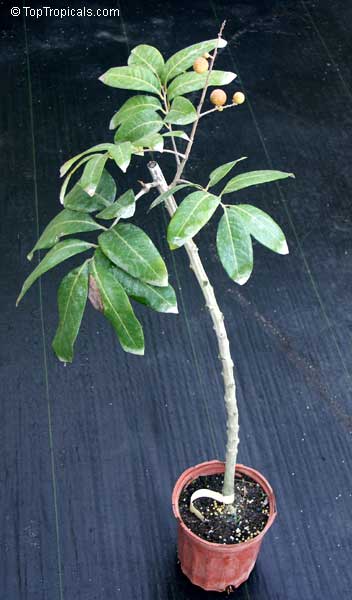Dimocarpus longan (Longan)
Top Tropicals Plant Encyclopedia
Botanical names: Dimocarpus longan, Euphoria longana, Nephelium longana
Common names: Longan, Dragon's Eye
Family: Sapindaceae
Hardiness: 35°F




The Dimocarpus longan, commonly known as Longan, is a fast-growing, small to medium-sized tree, rarely exceeding 20 feet in height. It can be pruned to maintain a small tree size. Once it matures, it flowers fragrantly with whitish-yellow blooms. The tree can thrive in USDA Zone 10-12 plant hardiness zones and is characterized by a preference for full sun and moderate moisture and low water requirements.
Longan is an evergreen tree with attractive, glossy, dark green leaves that are 1 to 4 inches long. The growth habit is wide spreading and the trunk up to 8 inches in diameter. The longan tree produce longan, a very sweet and juicy fruit. The fruit can be eat right off the tree or can be used in tea and desserts. The outer skin of longan is thin, and translucent brown in color, while the pulp is whitish-pink with a sweet flavor and musky aroma.
When it comes to growing and maintaining longan, the tree is not too picky in terms of soil, since it prefers sandy, fertile loam that is humus rich and well-drained. During the flowering period, the tree should be given additional nutrients to help the flowering process. For watering, a weekly watering cycle should be established, but keep in mind that this tree can tolerate short periods of drought.
In cold regions, the longan can be grown in containers. Although potted trees are not as hardy as those grown in opens spaces, they still should be placed in a sunlit area where they'll receive 4 to 6 hours of direct sunlight each day. Containers can also be placed close to buildings which can help protect them from the cold weather. As for the soil, the container soil should be rich, loose, and well draining. When watering, check the soil moisture before watering, and apply water only when the soil is dry to the touch.
The longan tree produces a plethora of health benefits. It is a rich source of vitamin C, potassium, magnesium, and dietary fiber, helping to promote your overall health. Loaded with antioxidants, longan boasts anti-inflammatory and anti-viral properties. Longan is also known to improve cognitive functions, boost energy and improve digestion.
This tree can provide a large amount of fruit of up to 70 kilos (150 pounds) per tree, depending on the specifics or size of the tree. Each fruit is about 1 to 1.5 inch in diameter. Longan fruit is normally eaten raw, but can also be cooked. It's often added to a mixture of honey, tea, and wine, or cooked in sweet syrup and served as a dessert.
Similar plants: Dimocarpus longan (Longan)
Recommended Fertilizer: SUNSHINE C-Cibus - Crop Nutrition Booster
SUNSHINE-Honey - sugar booster
Recommended Fertilizer: SUNSHINE C-Cibus - Crop Nutrition Booster
SUNSHINE-Honey - sugar booster
Recommended Fertilizer: SUNSHINE C-Cibus - Crop Nutrition Booster
SUNSHINE-Honey - sugar booster
7 gal pot. More developed root system, thicker trunk and branches. Plant height depends on growing season and variety. Dwarf varieties are slow growers and may be shorter. Contact us for exact size description if size/height matters to you. 7 gal plants may be shipped separately from other items by Ground service due to large size. See here time in transit (business days, excluding Sat-Sun!)
Recommended Fertilizer: SUNSHINE C-Cibus - Crop Nutrition Booster
SUNSHINE-Honey - sugar booster
Last one
Recommended Fertilizer: SUNSHINE C-Cibus - Crop Nutrition Booster
SUNSHINE-Honey - sugar booster
Recommended Fertilizer: SUNSHINE C-Cibus - Crop Nutrition Booster
SUNSHINE-Honey - sugar booster

























